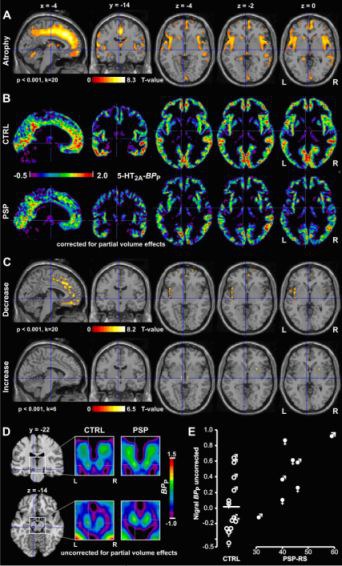Up-regulation of 5-HT2A receptors in progressive supranuclear palsy (PSP)
PSP is characterised by aberrant phosphorylation of protein tau and neurodegeneration in midbrain structures. The clinical symptoms comprise atypical Parkinson symptoms with paresis of vertical eye movements and subcortical dementia. Currently, no efficient treatment is available. In a sample of 8 PSP patients recruited at the Department of Neurology of the university of Marburg we found an increase of 5-HT2A receptor density by 60% in the striatum reaching 138% in the right caudate nucleus (compared to 13 healthy age matched controls). In the substantia nigra 5-HT2A receptors were detectable in PSP but not control subjects. These brain regions are crucial for the initiation and control of movement programs.

Figure: Study of 8 subjects with PSP versus 13 controls (CTRL). (A) T-maps resulting from a comparison of gray matter segments in PSP patients and controls using statistical parametric mapping (SPM) highlight cortical atrophy in PSP. (B) Averaged partial volume-corrected parametric maps displaying 5-HT2A binding potential BPP. (C) SPM T-maps display individual voxels with significantly decreased and increased BPP, respectively, thresholded at P = 0.001. (D) Comparison of averaged BPP maps of the nigro-striatal region in coronal sections (upper panel) and of the midbrain in axial sections (lower panel). Note increased specific binding bilaterally in the substantia nigra and striatum in PSP-patients. (E) Scatter plot demonstrating the correlation of the PSP rating score and the 5-HT2A binding potential BPP in the substantia nigra. The horizontal bar shows the average of controls.
